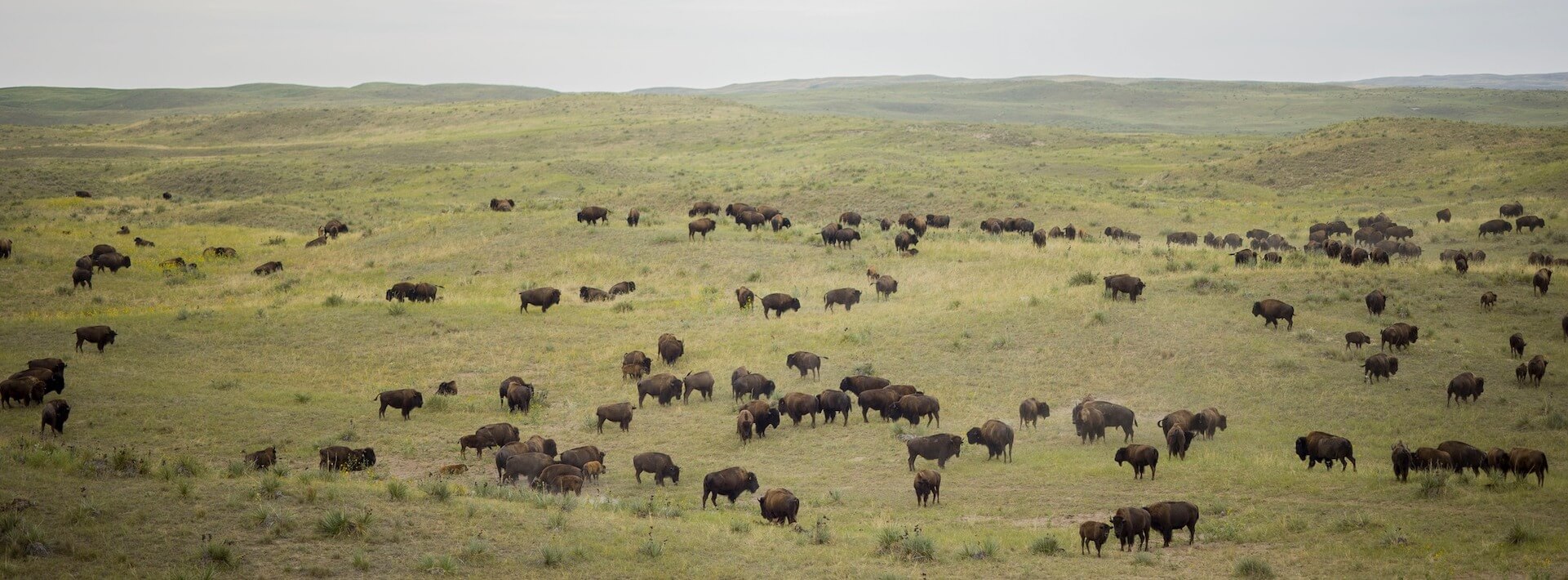ImpactAlpha, July 13 – It took five years of hard work for the Siċaŋġu Lak̇ota Oyate people to reestablish a 1,000-head buffalo herd on the Rosebud Sioux tribal lands in South Dakota.
With the Wolakota Buffalo Range, Siċaŋġu Co helped establish one of the world’s largest Native-owned buffalo herds, The 28,000-acre range represents a long-held, shared vision to restore the Siċaŋġu Lak̇ota Oyate tribal community’s bonds with the buffalo, along with the health and biodiversity of degraded land.
What made the initiative possible was early support from a small group of catalytic funders. The herd, now at full capacity, can yield about 75,000 pounds of meat each year. Wolakota has held about 15 harvests and is developing meat processing capabilities. The range is looking to sell at a premium to wholesalers off reservation in order to sell locally at subsidized rates.
The World Wildlife Fund funded the project’s feasibility study and introduced the Wolakota team to other funders. Turner Foundation covered early operational costs and connected Wolakota to industry experts. The Bush Foundation lifted its grant limits to help Wolakota cover a funding shortage for range infrastructure. This winter, historic blizzards dropped 20-foot snow drifts on the ranch, requiring temporary fencing to prevent buffalo from wandering off.
The collective funding has put Wolakota “on pace to be financially sustainable over the long-term,” says Aaron Epps of Siċaŋġu Co, which directs economic development efforts for the Siċaŋġu Lak̇ota nation. “What’s made this project successful is the relationships, and the shared risk our partners took on early in the partnership.”
The combination of grant funding, long-term invested partners and supportive networks demonstrates how catalytic capital can enable Native enterprises to evolve and thrive as sustainable businesses.
Indigenous business owners have been largely shut out from mainstream sources of debt and equity, a consequence of systemic extraction and financial trauma. Traditional capital structures are often not well suited, and can even be harmful, to the needs of small and growing Indigenous-owned businesses or to the unique environments in which they operate.
A new report from First Peoples Worldwide, “Indigenizing Catalytic Capital,” highlights the outsized impact potential of catalytic capital. To be effective, that catalytic capital requires terms and timelines tailored specifically to the needs of Indian Country.
“Deploying catalytic capital will not work if the process of delivery mirrors traditional forms of capital delivery,” the report says. “When colonial investment terms are replicated in a new context such as philanthropy or impact investing, without interrogation into how the terms themselves are extractive, these terms will continue to produce poor outcomes.”
In Wolakota’s case, its partners embraced the principles of Siċaŋġu Co’s “Seven Generations” investing framework, which is based on Lakota values for the world they’d like their descendants to inhabit over the next 175 years. Such social, environmental and economic missions are inherent to many Indigenous-led businesses.
“A lot of Native entrepreneurs don’t hype their social thesis, even though it runs right alongside their financial thesis,” says Kate Finn, who directed First Peoples Worldwide’s research. “There is a huge opportunity there for impact investors.”
Native leadership
There are an estimated 325,000 Indigenous-owned companies in North America transacting $38 billion in business each year. Yet private equity and venture capital have a negligible presence in Indian Country, and Native-led organizations receive less than one quarter of one percent of philanthropic funding.
“Every time that there’s a deal in Indian Country, it’s as if it’s the first deal,” observes Finn.
The First Peoples Worldwide reports attributes the chronic underfunding to the “invisibility” of Native people and their economies.
“The invisibility of Native economies means that, for the most part, non-Native members of the public aren’t aware of the economic dynamism in Indian Country, and investors and philanthropy aren’t seeing the opportunities that exist to support Native enterprises,” according to the report.
Invisibility also leads funders and investors to misconceive risk. The report from First Peoples Worldwide spotlights ecosystem obstacles, like lack of deal data transparency to address the issue of misconceived investment risk.
“Any investor who wants to be involved in the economic power that’s building in Indian Country has a place to step in,” says Finn. “It’s certainly not true that all investments in Indian Country are high risk. There’s a spectrum.”
Native entrepreneurs face a raft of obstacles and spend an outsized amount of time educating funders about Indian Country. Funders often show up with preconceived notions and stereotypes that founders have to debunk.
Successful catalytic deals in Indian Country “operate at the pace of relationship, shift power through Native leadership, and enable long-term success through flexibility and renegotiation,” the report says, offering recommendations on how to appropriately tailor and steer catalytic capital toward Native businesses and communities.
“If done well, activating catalytic capital will spur new approaches to capital delivery in Indian Country that center Indigenous solutions,” the report explains. “Capital then becomes an input to activate Native leaders’ visions, rather than driving their decision-making.”
Catalytic grants
Grants are an essential form of early funding to chronically overlooked entrepreneurs and fund managers, helping them build capacity, set up business infrastructure, onboard staff, support day to day operations—and facilitate investment readiness for other forms of capital.
In Indian Country, “grants also make capital stacks viable in situations where Native entrepreneurs must overcome systemic inequities to build their businesses,” First Peoples Worldwide finds.
Grants are overlooked as an essential form of catalytic capital. “We found that grants are foundational to the definition of catalytic capital in Indian Country,” the report’s authors write. “Integrated capital, which combines both grants and investments, is the most catalytic form of capital for Native entrepreneurs.”
The World Wildlife Fund provided Wolakota with a grant for a feasibility study, paid the organization’s first year’s land-lease, and covered the cost and transport of the first 100 buffalo. The Turner Foundation, created by cable entrepreneur Ted Turner, came in with early grant funding once the project got underway in 2020, and re-upped to support Wolakota’s range operations. The Bush Foundation provided two slugs of grant funding to meet the organization’s $7 million infrastructure needs, including fencing, barns and roadways.
In addition, Wolakota secured several long-term, flexible loans that the organization has used to finance various needs as the early business needs grew and evolved. One slug of debt is being used to add on-site housing for staff. Most of Wolakota’s loans were structured for 10 and 15 year repayment periods, with interest only payments for the first five years.
“The terms we got were really tailored to the project,” says Epps.
The organization will continue to grant-fund a number of its educational and cultural initiatives, like youth camps and partnership with a Lakota immersion school to teach students about rearing and caring for the buffalo.
Success factors
What enabled the range to successfully take off, however, was the holistic support Wolakota’s funders provided. First Peoples Worldwide calls this “catalytic capital +.”
Before WWF became a backer, it championed the project to a long list of industry partners, consultants, federal contacts, foundations and investors in its network. It provided technical assistance to help Wolakota develop its business model. And it designed a first-of-its-kind fundraising campaign that enabled Wolakota to raise more than $300,000 directly from WWF’s donors.
The Turner Foundation, a relationship facilitated by WWF, connected Wolakota’s team to Turner Ranches, one of the largest bison ranch operators in the world, for technical assistance and operational support. The Bush Foundation, upon learning that Wolakota had a startup funding shortfall, changed its internal grant limits to cover the $1.8 million gap.
“Every investor that has come in has taken the time to get to know us and has cared deeply about the project itself,” says Epps. “That’s what made it successful.”
Also key: “Respect for the tribal sovereignty element of the project,” Epps adds. “No one came in and told us ‘this is how you should do it,’ and if they had, those conversations wouldn’t have gotten very far. Native communities are fed up with that approach. Successful projects and businesses in tribal communities have to be community-driven, led by the folks on the ground.”
First Peoples Worldwide’s report outlines a number of recommendations for funders and investors to tailor and steer catalytic capital into Indian Country. Among them: mobilizing catalytic grants as “equity-like” financing and first-loss layers for credit and debt within early blended-finance transactions.
For philanthropic funders, grantmaking teams can help foster connections between Native entrepreneurs and program-related and mission-related investment teams, so business owners can graduate up the catalytic capital ladder.
Leaning on Native intermediaries can help investors mitigate risk and find viable deals in Indian Country, just as investors should lean more on local fund managers for market intelligence, dealflow and capital deployment in emerging and frontier markets.
“Indian Country is really a domestic emerging market and needs to be thought about in that way,” Finn says. “Native intermediaries know the space well. They know how to deploy capital and support entrepreneurs. They’re probably the best way to get creative capital out to entrepreneurs in ways that entrepreneurs can use it.”











